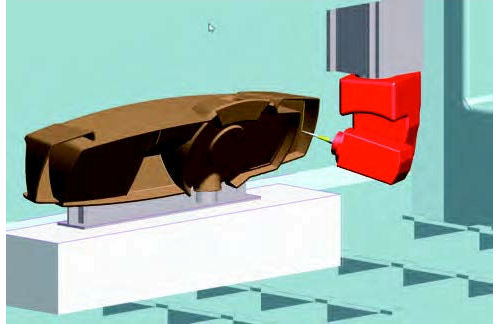
With the help of hyperMill, Gianoplast recently made an instrument panel for a yacht out of a block of stratified resin.
Latest News
June 1, 2014
 With the help of hyperMill, Gianoplast recently made an instrument panel for a yacht out of a block of stratified resin.
With the help of hyperMill, Gianoplast recently made an instrument panel for a yacht out of a block of stratified resin.When making molds for large-sized and high-precision parts, using CAM software is inevitable. In the case of style components, like those earmarked for the marine industry where the design of the shapes includes sophisticated geometries and high-quality surfaces, CAM is able to help the user with adequate processing and machining strategies. To make an instrument panel for an innovative yacht from the Wider shipyard, Gianoplast made full use of the powerful tools found in hyperMill, CAM software from Open Mind Technologies that can be used to program the complete process and more complex parts.
When owner Claudio Fioroni, along with his colleague Antonio Baroni, started using hyperMill they approached it carefully: “When the production period was over, we then experimented with the possibility of using the 5-axis milling machine with CAM software to make models which, up until then, had previously been made by hand out of wood,” Fioroni says. “For a company like ours, which specializes in thermoforming and making parts out of fiberglass, working with complex geometries and in the most difficult positions is par for the course, therefore, we needed a form of software that could effectively support 5-axis machining. As a result of working very well with hyperMill over many years we decided set up a sort of alliance with Open Mind, which ended up with us also buying the latest hyperMaxx module for high-performance roughing. We mainly supply large-sized parts and the use of hyperMaxx prevents any downtime, considerably speeding up the production processes.”
A Model ‘Dashboard’
Fioroni says a lot of thought went into the instrument panel that they made for the Wider shipyard. Besides being a considerably large part, it also had to be made out of just one block of stratified resin, which was then coupled with a carbon fiber component from another company that also had a number of different openings in it to house all the yacht’s control instruments.
“Therefore, the level of precision had to be spot on, an aspect that we had to take into consideration as early on as the initial mold design phase,” Fioroni says. “This meant assessing any possible material shrinkage and its behavior during the production process, to ensure that the finished part had the same measurements as those specified in the customer’s design and was a perfect match for all the other parts of the yacht.
 A 360° machining process was carried out to create a ‘visible’ result both at the front and at the back.
A 360° machining process was carried out to create a ‘visible’ result both at the front and at the back.Unlike many other instrument panels, the design by the Wider shipyard also included a ‘visible’ component both at the front and the back. So Gianoplast positioned the part in such a way so as to be able to work on it from all angles, also reaching the most hidden areas and leaving just a few support points.
“By doing so, we created an exact copy of the production components, which, in collaboration with one of our associates, GR Composites, we created a cast that was used to make the final parts,” Fioroni says. “This decision was made because it involved making a limited number of parts, which, however cheap, did not justify using thermoforming. Without the help of 5-axis milling we would have had to cut the part in half to be able to work first on one side and then on the other. However, with 5-axis milling we managed to reach the entire surface of the part, once removed from the block, we created a finished part that needed no further attention.”
A Reliable Partner
“The decision to use hyperMill provided the right strategies to solve all the processing problems,” Fioroni continues. “In particular, the automatic collision check and avoidance function stops the tool or spindle affecting the parts of the component. This enables us to use ‘standard’ tools also for complex processes like this, without having to buy any expensive tools that are tailored to suit specific situations. Furthermore, given the high level of reliability of this collision check function, with the exception of certain processes carried out at the limit of feasibility, the milling machine can operate unmanned, a big advantage in terms of timesaving.
Before going home at night, Gianoplast employees loaded the workpiece and set the process in motion and, in the morning, when they returned to work, they found the finished product. They also noticed how hyperMill can be used to create 5-axis machined parts with minimum machining signs. “This aspect is imperative when it comes to manufacturing parts made out of fiberglass where the surface quality has to be impeccable, as in the case of the instrument panel,” Fioroni says.
“These are functions that are found in hyperMill but, given the numbers, it’s not easy to remember all of them: the effective collaboration from the staff at Open Mind enabled us to find the right function and successfully apply it,” Fioroni says. “When we bought hyperMaxx, for example, Open Mind technician Giovanni Scarfato wanted to check the actual improvement in productivity obtained by introducing the new roughing module.”
One of the main advantages of using hyperMaxx is its ability to remove large volumes of material and dynamically optimize both the movements and the speed so as to ensure machining rapidity and evenness, Fioroni adds.
More Info
Subscribe to our FREE magazine, FREE email newsletters or both!
Latest News






